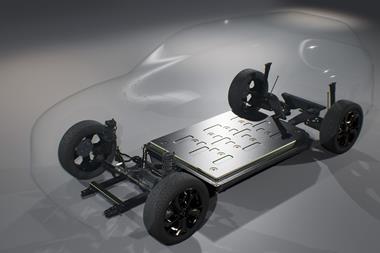
Toyota’s production facility in Valenciennes, France and the influence of the Toyota Production System
A lot of well-known international companies have their beginnings in humble roots. An example of this is the Toyota Motor Corporation (TMC), which you may know started in 1933 as the Toyoda Automatic Loom Works, manufacturing weaving looms that featured an automated return shuttle invented by Sakichi Toyoda, father of Kiichiro, who went on to form TMC in 1937. The original loom, which in 2000 was donated to London’s National Museum of Science and Industry, is still in full working order. The drive to create reliable products would appear to run in the family; recent recall issues aside, the car company founded by Kiichiro Toyoda is world-renowned for the reliability of its products.
Plant timeline
1998 – TMMF founded
2001 – SOP (initial plant capacity 150,000upa, 2,000 employees)
2002 – Increase capacity to 184,000upa, due to success of Yaris in Europe
2003 – New Yaris introduced
2004 – Third shift added
2005 – Yaris II
2006 – 1m Yaris units produced
2008 – Yaris II facelift
That said, any feature covering TMC must briefly address the recent recalls, largely based on reports of ‘unintended acceleration’ in some models. Yet for the purposes of an article about manufacturing at Toyota, there is no story. Etienne Plas, Senior Manager of Corporate Communications, Toyota Europe: “When the recall story broke, journalists from all over the world wanted to visit Toyota plants, they wanted to see what was wrong with the production process. But there was never anything wrong with the production process. The plants producing the cars in question were simply building vehicles with approved parts.”
Following the recalls, Akio Toyoda, President of TMC, announced the launch of the company’s Global Quality Committee (GQC), with the intention of steering quality improvement activities to a new, higher level. Officers serving on the committee, chaired by Toyoda, have been selected from the principal geographic regions of Toyota’s manufacturing activities and include the former Director of Toyota Motor Manufacturing France (TMMF), Didier Leroy. “A ‘Business
The 5S system is designed to outline what needs to be done to create an efficient workspace. This can be applied at an individual level, where a worker follows the guidelines in their own station, or applied to the plant as a whole.
Seiri - sort
• essentially the task of separating what is from what is not required
Seiton - straighten
• in this context, the correct position of an unused tool is outlined
Seiso - shine
• cleaning the workstation, both for effi ciency and in respect to the next worker
Seiketsu - standardize
• always look for best practice and inform others through clear instruction
Shitsuke - sustain
• recognizing that something can be improved to maintain fl ow between stations
Reform Customer Satisfaction and Audit Division’ will be in place at the Valenciennes plant to deploy the directives (from the GQC) and investigate improvements,” says Plas.
The Toyota Yaris, manufactured at the TMMF plant in Valenciennes, France, was part of the recall. But that aside, what was the motivation behind the decision to locate the plant in northern Europe, an area well known for its high labour costs? Francois-Regis Cuminal, Communications Director at Valenciennes says that there were a variety of compelling reasons. “The plant location reflects the underlying Toyota strategy of producing vehicles in close proximity to important markets. In addition to this, before the plant was constructed the local unemployment rate was 23%, so we knew there was a lot of available manpower in the area. The infrastructure was already in place, highways and rail links, and a nearby airport. We also ship cars from Zeebrugge (Belgium), the port is 130km from the plant.” He adds the employee turnover is only 3%, a demonstration of the importance of the plant to the region.
Facility operations are designed to extract as much value from the plant as possible, says Cuminal. “This is a highperformance, lean organisation. The three-shift operation is a key element of TMMF.” Does the plant balance the wage bill with an increased percentage of automated processes? “TMMF does not use automation to compensate for the higher labour cost. There is some automation, but human intervention is maintained at critical steps to ensure quality control and optimal flexibility.”
 Manufacturing summary
Manufacturing summary
Toyota operates a series of plants across Europe. In addition to TMMF, the carmaker builds cars in the UK (Avensis, Auris, Auris Hybrid), Turkey (Corolla Verso and Auris) and Russia (Camry). Toyota also has two European joint-venture plants, a commercial vehicle plant in Portugal (Dyna, Hiace, Optimo) and TPCA (Aygo, Citroën C1 and Peugeot 107), located in the Czech Republic. Engines are produced in both the UK and Poland, the latter also delivering gearboxes. In addition to imported vehicle distribution, Toyota Logistic France also manages the export of vehicles produced by TMMF.
“Traditionally our top market is Italy, but last year the incentives in Germany made that our strongest market. We exported 18% of production to Germany, 14% to the UK and then Italy, France and Spain.” There is clear disappointment in mentioning France as a comparatively nominal market for the Yaris; it is perhaps the Toyota brand that defies greater success in France, the nation’s carbuyers well-known for their support of national car brands. “We would like French sales to be higher. The Yaris is more French than other models, for example the (Slovenian-built) Renault Twingo.” Backing up that statement, he adds that the car was even designed in France, at the Toyota studio in Nice.
In total, says Cuminal, about 90% of the part value in European-built Toyota vehicles is sourced from European suppliers.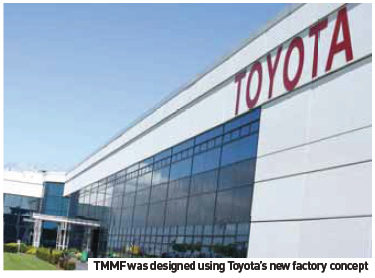 As for suppliers delivering to TMMF, there is no supplier park surrounding the plant. Instead, parts are delivered from regional Tier companies and also from Japan; parts shipped from the home market have a lead time of six weeks. In addition, a series of affiliated Toyota companies supply parts and plant services; Toyota Tsucho delivers parts and also acts as a service provider, carrying out activities that include waste water management. Cuminal says that only seats and wheels are delivered to the assembly line justin- time and just-in-sequence, the latter delivered by Toyota Soshoku, which with Toyota Mi also produces spare parts for vehicles no longer in production. Future plans will see Toyota Mi also delivering parts to TMMF.
As for suppliers delivering to TMMF, there is no supplier park surrounding the plant. Instead, parts are delivered from regional Tier companies and also from Japan; parts shipped from the home market have a lead time of six weeks. In addition, a series of affiliated Toyota companies supply parts and plant services; Toyota Tsucho delivers parts and also acts as a service provider, carrying out activities that include waste water management. Cuminal says that only seats and wheels are delivered to the assembly line justin- time and just-in-sequence, the latter delivered by Toyota Soshoku, which with Toyota Mi also produces spare parts for vehicles no longer in production. Future plans will see Toyota Mi also delivering parts to TMMF.
Plant setup
The TMMF facility is located on a purpose-built site located outside Valenciennes in Oannaing. “The plant is situated on a large site, land which could be used to expand the facility as required,” explains Cuminal. Asked if there any plans to go ahead with expanding the plant, he says that as the facility is currently running under full capacity, there are no such plans as yet.
Construction of TMMF was completed in 2001 (see plant timeline box), at a cost of €610m. With two later phases of improvements, including the expansion of the existing press facility, total plant investment has topped €1bn. According to Cuminal, the Valenciennes facility was the first in a new plant concept for Toyota, in that that all operations are housed in a single building. TPCA was also based on this concept, though as the second plant delivered under the programme, it incorporates a series of minor improvements. “(TMMF) has a closely integrated process, we go from steel coil to final car, including the plastics shop, all under one roof.”
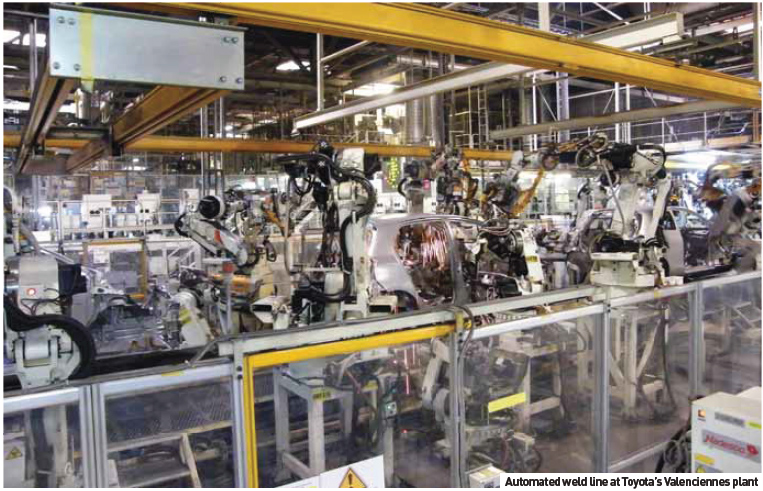 The plant features a ‘cross dock’ for parts reception, which also marks the start of the internal logistics process, where delivered parts are organised to match the production schedule and prepared for lineside delivery. Cuminal points out that this area is essentially the first of the many quality gates located throughout the production process. Unusually, major plastic parts, including bumpers and instrument panels, are not fed through this area but are manufactured in the facility’s own dedicated department.
The plant features a ‘cross dock’ for parts reception, which also marks the start of the internal logistics process, where delivered parts are organised to match the production schedule and prepared for lineside delivery. Cuminal points out that this area is essentially the first of the many quality gates located throughout the production process. Unusually, major plastic parts, including bumpers and instrument panels, are not fed through this area but are manufactured in the facility’s own dedicated department.

The design of the facility building is perhaps the largest single area at TMMF that falls under the globally-recognised Toyota Production System (TPS). Cuminal points out that the new factory concept was developed in conjunction with the underlying principles of the TPS, leading to a 30% reduction in the building’s overall footprint in comparison to operations with a similar capacity. “The plant is very compact,” he says, “maybe more so than TPCA.” In that Toyota is constantly looking to improve the production process, does that extend to building design? “As plants are built around the world, Toyota learns from its mistakes. The reduction in area is a reflection of that.”
The reduced floorspace has heavily influenced the overall manufacturing process, with equipment arranged to make best use of the area. Processes must also be adjusted to suit the layout. “There is less equipment and less space between adjoining stations. It also means less space for buffers and part storage. With a low buffer level, if you’re not building in quality, the plant could completely stop.” There is also very little space reserved for vehicle rework at the end of the line, but Cuminal says that quality checks throughout the production process mean few cars require any postproduction work. In his words, you can’t send a lot of cars to the end of the line because there simply isn’t the space. The 30% reduction in the size of the plant has created a proportional reduction in generated waste. “Everything here has been designed to have the lowest environmental impact on the surrounding area,” says Cuminal. In addition to using water-based paint and replacing cardboard with reuseable plastic containers for part delivery, kaizens developed through the TPS have reduced overall energy consumption by 40% (divided equally between gas and electricity). A rainwater collection pool has enabled the plant to reduce the amount of water drawn from the local utility by 70%. VOC emissions have been cut by 50% and the plant has been rated as a zero landfill facility since 2007. “Wherever possible everything is reused,” says Cuminal.
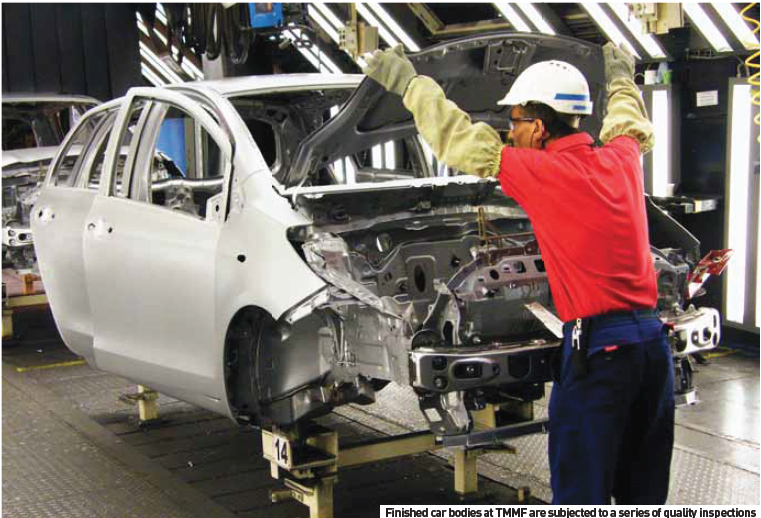 “TMMF is one of five Toyota plants in the world considered an environment leader in its use of innovative technologies to save energy.” As part of this on-going effort, the logistics centre has had 37 photovoltaic membranes installed on its roof, while part of the press shop extension currently under construction includes a solar wall. “This is a heat exchanger, it heats air and that will be used to heat the buildings.” The estimated energy saving for that single installation is approximately 30%.
“TMMF is one of five Toyota plants in the world considered an environment leader in its use of innovative technologies to save energy.” As part of this on-going effort, the logistics centre has had 37 photovoltaic membranes installed on its roof, while part of the press shop extension currently under construction includes a solar wall. “This is a heat exchanger, it heats air and that will be used to heat the buildings.” The estimated energy saving for that single installation is approximately 30%.
Product and process
TMMF currently produces 612 units of the Yaris threeand five-door hatchback per day on a single line. Variants include 1.0 and 1.3 litre petrol engines and the 1.4D (D4D), all of which are EuroV compliant. Manual and automatic transmissions are offered, with other powertrain and equipment variations. Yaris models built in Valenciennes are exported to 24 markets and account for approximately 25% of all European Toyota sales (2009 figures, total Euro sales 855,000, 216,000 Yaris).
As mentioned, TMMF works on three shifts – it is the only Toyota plant in the world to work this pattern. In 2007, the plant produced 270,000 units, its highest annual production figure to date. This was based on a 60 second takt time and with 4,000 employees.
Production at TMMF starts in the press shop, where at full capacity, the presses process 200 tonnes of steel coil per day, supplied by ArcelorMittal. Steel thickness varies between 0.5 and 2mm, depending on the part being produced. Steel blanks are cut using a 700-tonne Schuler blanking press, while two Komatsu transfer presses deliver finished parts. Changeover times for the Japanese-supplied die tooling has been much improved. Whereas it used to take between one and two hours, the switch now takes between five and seven minutes. Pressed parts are manually inspected before being returned to the conveyor for automated picking and racking. “On the big presses, we’re producing all the outer parts and subcomponents for the chassis,” explains Francois-Regis Cuminal. He points to the plasma screen that is above the conveyor at the end of the press line. “The screen shows the part that is being made and the key areas that need to be checked. The standard is not defined by engineers, it is defined on the shopfloor by the group leader and then validated by a quality group. They have the responsibility to improve the standard, which can be done through suggestions and applied improvements. The standard is key. If you maintain standards, you maintain quality. Safety, economy, quality. When you have a good standard, you have good quality.”
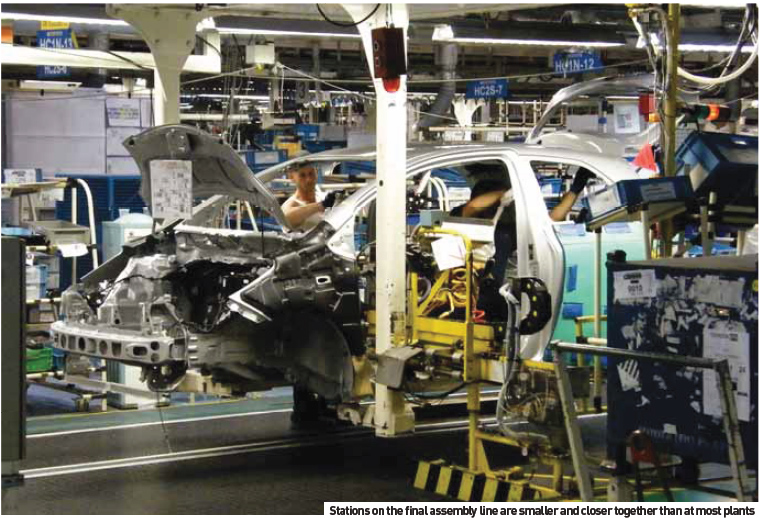 Buffers between the press shop and weld shop hold just a single day’s part supply. Moving through into the welding area, Cuminal notes that the shop is not 100% automated – an actual application of the company not automating to replace labour. “About 35% of all welding processes are completed by hand. There are two reasons for this. We are not at full capacity and it also improves our flexibility. We can quickly react to redesigns and styling changes.” Walking through the welding shop, the manual welding stations are in closer proximity to each other than in other car plants, but he explains that this is part of the TPS known as ‘5S’, designed to enable visual management. Follow these guidelines and there is ample space to complete a given task.
Buffers between the press shop and weld shop hold just a single day’s part supply. Moving through into the welding area, Cuminal notes that the shop is not 100% automated – an actual application of the company not automating to replace labour. “About 35% of all welding processes are completed by hand. There are two reasons for this. We are not at full capacity and it also improves our flexibility. We can quickly react to redesigns and styling changes.” Walking through the welding shop, the manual welding stations are in closer proximity to each other than in other car plants, but he explains that this is part of the TPS known as ‘5S’, designed to enable visual management. Follow these guidelines and there is ample space to complete a given task.
“The method eliminates everything that is unnecessary, and in doing that, the worker can eliminate waste and achieve maximum efficiency, productivity and quality. This is a key part of the TPS. Only when a part meets the required standard can it be passed along. Workers cannot and do not pass along parts that are inferior or sub-standard.” Where the welding is not completed by hand, one of 200 robots carries out the joining process. Each car body represents a total of approximately 3,000 welds, of which most are spot welds, with a small amount of MAG and arc welding. Finished bodies are subjected to a rigorous inspection process, which includes an automated check of the dimensions of each carbody to judge build accuracy. Completed car bodies are moved directly from weld through to the adjoining paintshop, where the first step is to apply sealant. A two-step operation, most product is applied by robots before workers check the application and also add more sealant. “Quality levels must be equal on both sides of the car so workers in this area are trained to use both hands to carry out the operation,” says Cuminal. “This allows them to comfortably and accurately complete the work.” In the paintshop, car body exteriors are painted by robots, while interiors are sprayed by hand. The Yaris is offered in a choice of ten colours, the paint product held in interchangeable cartridges. In addition to facilitating very quick colour changeovers with very little waste, this means that there is no blocking on the line - any car can be painted any colour at any time. A further element of the TPS is demonstrated by the variable-height conveyor used in the paintshop. “When the worker is comfortable, they do better quality work. Good (working) conditions mean good quality.”
The complete paint process is started with the application of a solvent-based primer coat, which is followed by the water-borne base colour coat and a solvent-borne, 2K product top coat. The carbodies are flashed off in ovens between each process step.
Trim and final assembly follows paint, which in terms of automation, Cuminal describes as a ‘classical’ process, meaning there are few automated processes. Like the weld shop, the stations on the line are smaller than others, another example of the 5S system being used to organize and optimize station layout and process.
At full capacity, TMMF would have approximately 4,000 employees. The reduced output has also cut the workforce at the  plant, with 3,000 currently required to man the three shifts. At full capacity the takt time would be 60 seconds, but to match market demand, it now stands at 108 seconds. The line, too, has been slowed down. In fact, it is periodically brought to a halt in order to reduce finished vehicle output The number of stations on the assembly line can flex in order to meet requirements. “I don’t know how many stations there are right now, it’s not a fixed number,” says Cuminal. “When there is a shorter takt, fewer operations are completed per station, so more stations are added. With the longer takt, more operations can be completed in a single station so stations are removed from the line. Fewer workers are required for the reduced number of stations.”
plant, with 3,000 currently required to man the three shifts. At full capacity the takt time would be 60 seconds, but to match market demand, it now stands at 108 seconds. The line, too, has been slowed down. In fact, it is periodically brought to a halt in order to reduce finished vehicle output The number of stations on the assembly line can flex in order to meet requirements. “I don’t know how many stations there are right now, it’s not a fixed number,” says Cuminal. “When there is a shorter takt, fewer operations are completed per station, so more stations are added. With the longer takt, more operations can be completed in a single station so stations are removed from the line. Fewer workers are required for the reduced number of stations.”
A part of the TPS that can now be found on most assembly lines across the world is the andon system. “The andon is a symbol of Toyota,” he continues. “It is a symbol of quality. If there is a problem, we stop the line. If the problem can’t be immediately solved, then the team leader must solve the problem, whether it is technical or part-related. “When the employee has a defect, he has a responsibility to stop the line. The problem must be solved before the car goes to the next step.” It’s a concept that runs throughout the plant. “When a new employee is on the line, they don’t want to pull the andon. The first time they hear yelling further down the line and the line is stopped because of their mistake, they never have a problem pulling the cord again.” Design elements of the Yaris also assist in streamlining final assembly. As the binnacle is located in the centre of the instrument panel, the same IP can be used for left- and right-hand drive models. Of course, the underlying idea is that the driver’s eye is naturally drawn to the right, so better to position the speedometer, etc. in that direction, but it’s one less large part that must be delivered lineside.
The sense of success demonstrated in explaining the removal of a single part from the manufacturing process is typical Toyota. “The TPS is a very large number of very small steps,” says Cuminal. “Toyota is not a company that likes revolution, A to Z in one go. Instead, it goes from A to B to C.” While this explains the individual lineside delivery ethos, it’s also a good description of TMMF, from how employees are trained, though to how improvements are fed into the design of new facilities. Although no definitive cause for the recent recalls has been made public, it would be surprising if the manufacturing part of the TPS had played any significant role. As it stands, the reputation of the production methodology remains untarnished, which is a good thing, considering the importance it plays at Toyota and the other OEMs which also use key parts of the system at their own plants.
The TPS exists under the umbrella of ‘The Toyota Way’, which in broad terms outlines how business at TMC is conducted, from the respect shown to individual employees, through to how business is conducted on an international level. The system can be altered to accommodate the local management style, but the basic values remain the same. The following are some key terms and explanations that outline the basis of the TPS, which since its inception has been adopted (in varying degrees) by most major automotive OEMs.
Jidoka
One of the two main pillars of the TPS, this refers to the ability to stop production lines, by man or machine, in the event of problems such as equipment malfunction, quality issues or late work. Jidoka helps to prevent defects from travelling down the line, while also identifying and correcting problem areas using localization and isolation, building quality into the production process.
Just-In-Time (JIT)
The other main pillar of the TPS. JIT refers to the conveyance and manufacturing of only what is needed, when it is needed, and in the amount needed. It is built upon three basic principles:
• The pull system
• Continuous flow processing
• Takt time
Andon
A visual control that displays the current state of work (i.e., abnormal conditions, work instructions and job progress information). It is one of the main tools of Jidoka.
Genchi Genbutsu
Go and see the problem. This is the belief that practical experience is valued over theoretical knowledge. You must see the problem to know the problem.
Heijunka
The overall levelling of the produced volume and variety of items in the production schedule over a given time period. Heijunka is a prerequisite for just-in-time delivery.
Hoshin
Goals (with targets) and the means for achieving those goals, designed to address business priorities and moving the organization on to a new level of performance; variable from year-to-year; could also be multiyear, this is developed by executive management.
Jishuken
Management-driven kaizen activity where management members identify areas in need of continuous improvement and spread information through the organization to stimulate kaizen activity.
Kanban
A key control for JIT production; it serves as:
• Instruction for production and conveyance
• Visual control tool to check for over production and to detect irregular processing speeds
• Tool to perform kaizen
Kaizen
A system of continuous improvement in which instances of Muda (waste) are eliminated one-by-one at minimal cost. This is performed by all employees rather than by specialists.
Muda
Muda is translated as waste; anything that does not add value. There are seven types of muda: Overproduction, waiting, conveyance, processing, inventory, motion, correction.
Muri
The process of not overburdening an individual worker, assigning a task that fi ts the worker’s skill set and that can be completed within the takt. To not achieve the correct task fi t is second form of waste.
Mura
Supplying the right part at the right time in the right amount. Deviations from the ideal are considered a third form of waste.
Nemawashi
Preliminary work that involves other sections/departments in discussions to seek input, information and/or support for a proposal or change that would affect them.
Pokayoke
Low cost, highly reliable devices used in the jidoka system, that will stop processes in order to prevent the production of defective parts.


































